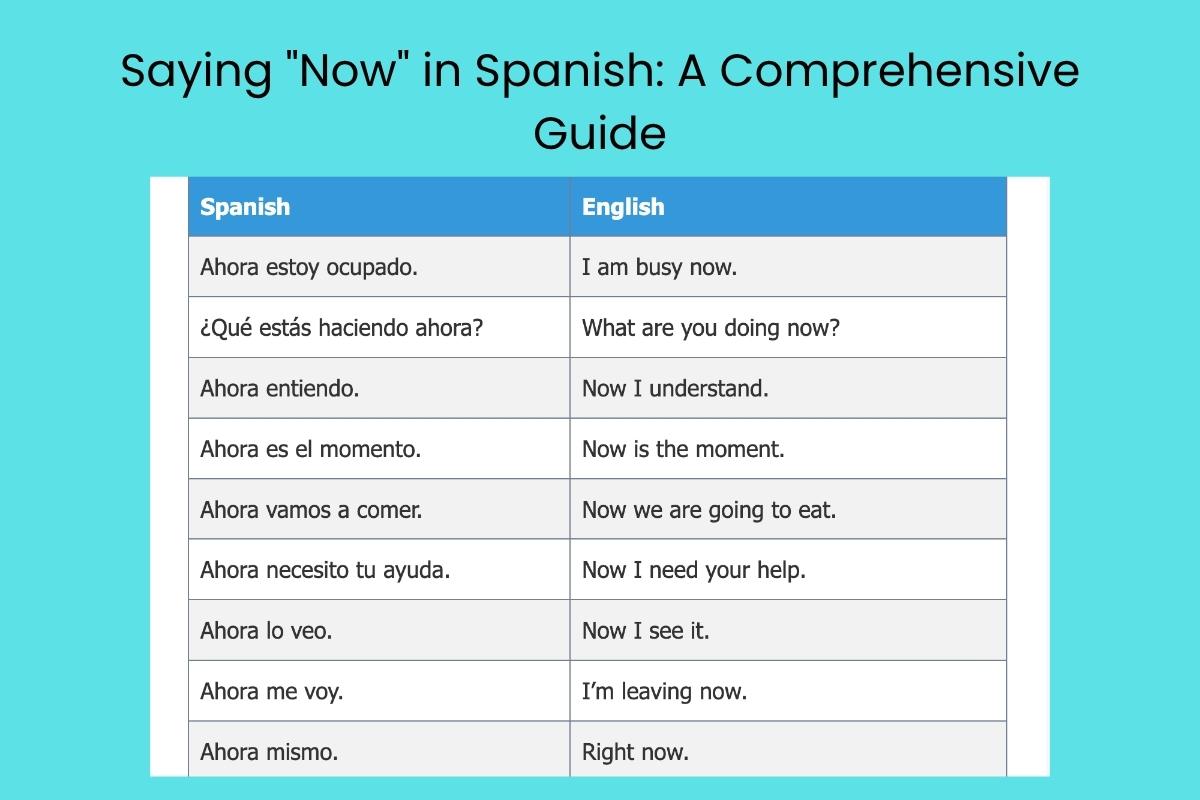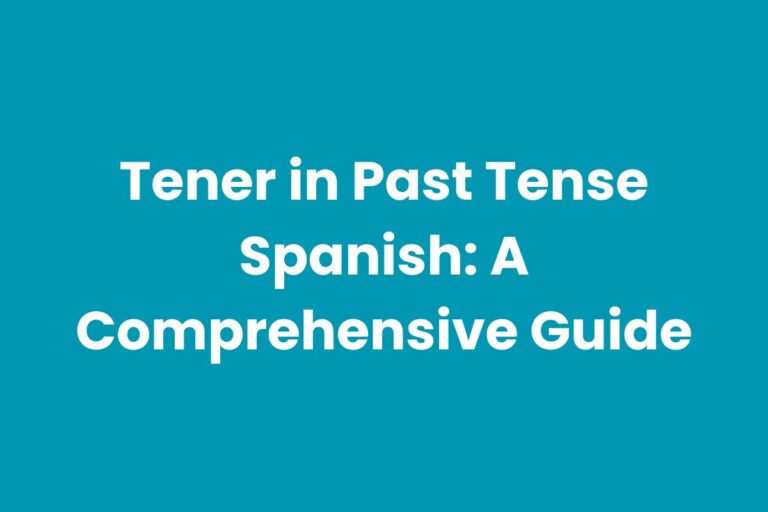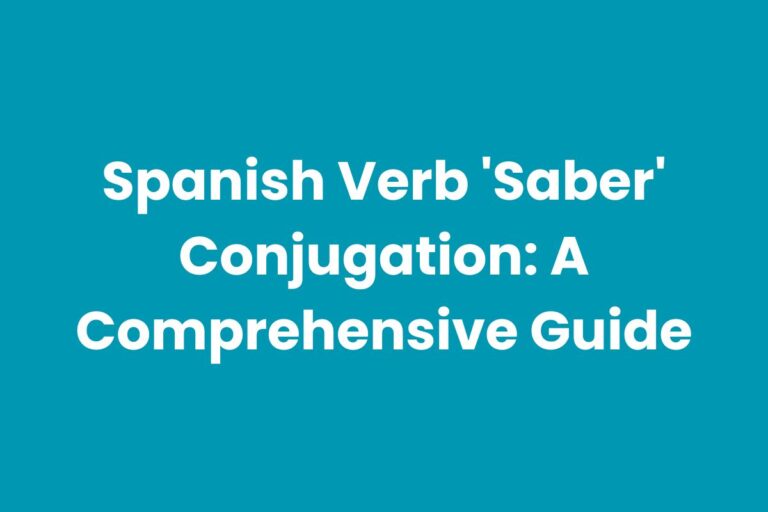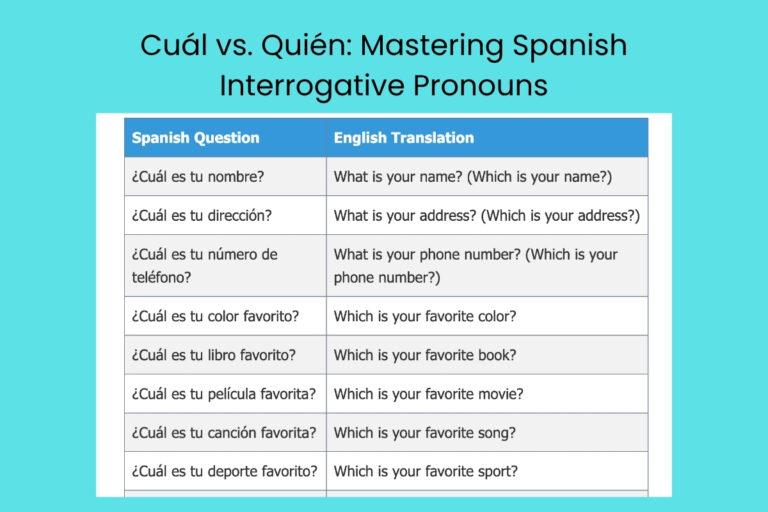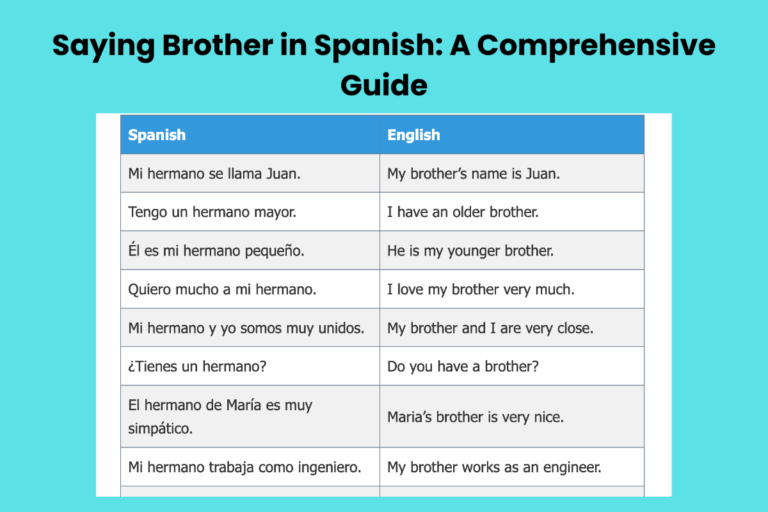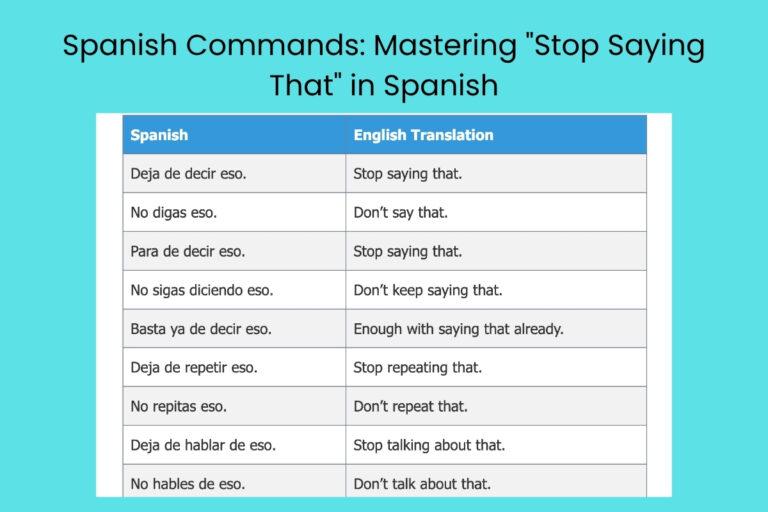Saying “Now” in Spanish: A Comprehensive Guide
Understanding how to express “now” in Spanish is crucial for effective communication. While “ahora” is the most common translation, Spanish offers a variety of ways to convey the concept of “now,” each with its own nuance and context.
Mastering these variations allows you to express immediacy, urgency, or temporal relationships with greater precision. This guide is designed for learners of all levels who wish to expand their vocabulary and improve their fluency when discussing time and action in Spanish.
This article will benefit students, travelers, and anyone interested in enhancing their Spanish language skills. By exploring the different ways to say “now,” you’ll gain a deeper understanding of Spanish grammar and improve your ability to express yourself accurately and naturally.
We will cover everything from the basic translation to more advanced usages, ensuring you can confidently use “now” in any situation.
Table of Contents
- Definition of “Now” in Spanish
- Structural Breakdown of “Ahora”
- Types and Categories of “Now” in Spanish
- Examples of “Now” in Spanish
- Usage Rules for “Now” in Spanish
- Common Mistakes When Saying “Now” in Spanish
- Practice Exercises
- Advanced Topics
- Frequently Asked Questions
- Conclusion
Definition of “Now” in Spanish
The concept of “now” in Spanish encompasses the present moment, the immediate future, or a sense of urgency. While the most direct translation is ahora, the Spanish language offers a variety of words and phrases to express different nuances of “now.” These variations depend on the context, regional differences, and the speaker’s intention.
Understanding these nuances is crucial for mastering the expression of time in Spanish. Each word or phrase carries its own weight and can significantly alter the meaning of a sentence. For example, ahorita, a diminutive form of ahora, can mean “right now” in some regions but “later” in others, illustrating the complexity and richness of the Spanish language.
The function of these words and phrases is to pinpoint a specific time frame, indicating when an action is taking place, should take place, or has already taken place. They can act as adverbs modifying verbs, adjectives, or even entire clauses, adding temporal context and clarity to the message.
Their use can also convey a sense of urgency, delay, or expectation, shaping the overall tone of the communication.
Structural Breakdown of “Ahora”
The word ahora is an adverb of time in Spanish. It’s derived from the Latin phrase hac hora, meaning “at this hour.” Its structure is relatively simple, consisting of a single word that directly modifies the verb or clause it accompanies. Ahora typically appears before or after the verb, depending on the desired emphasis and the sentence structure.
In compound sentences or complex clauses, ahora can be used to establish a temporal relationship between different actions or events. For instance, it can be combined with conjunctions like que (that) or cuando (when) to create more nuanced expressions of time. The placement of ahora within these structures is crucial for conveying the intended meaning accurately.
Consider the following examples to illustrate the structural flexibility of ahora:
- Ahora estudio español. (Now I study Spanish.)
- Estudio español ahora. (I study Spanish now.)
- Ahora que tengo tiempo, voy a leer. (Now that I have time, I’m going to read.)
Types and Categories of “Now” in Spanish
Spanish offers several ways to express “now,” each with distinct connotations and usage. Understanding these variations is key to speaking Spanish fluently and accurately.
Ahora
Ahora is the most common and direct translation of “now.” It indicates the present moment or immediate future. It’s versatile and can be used in a wide range of contexts.
Ahorita
Ahorita is the diminutive form of ahora. Its meaning can vary significantly depending on the region. In some Latin American countries, it means “right now” or “very soon,” implying immediacy. However, in other regions, it can mean “later” or “in a little while,” indicating a slight delay. This regional variation makes it essential to understand the context in which ahorita is used.
Ya
Ya has multiple meanings, including “now,” “already,” and “enough.” When used to mean “now,” it often implies urgency or expectation. It can also indicate that something has already happened or that an action should be completed immediately.
En Seguida
En seguida means “right away” or “immediately.” It conveys a sense of promptness and is often used when responding to a request or instruction.
Inmediatamente
Inmediatamente is a formal and emphatic way of saying “immediately.” It emphasizes the urgency and importance of an action being performed without delay.
Actualmente
Actualmente means “currently” or “at the present time.” While it relates to the present, it emphasizes the ongoing nature of a situation rather than a specific moment.
Examples of “Now” in Spanish
To fully grasp the nuances of each expression, let’s explore various examples categorized by the specific word or phrase used.
Examples with “Ahora”
Ahora is a versatile word that can be used in many contexts. The following table provides a range of examples to illustrate its usage.
| Spanish | English |
|---|---|
| Ahora estoy ocupado. | I am busy now. |
| ¿Qué estás haciendo ahora? | What are you doing now? |
| Ahora entiendo. | Now I understand. |
| Ahora es el momento. | Now is the moment. |
| Ahora vamos a comer. | Now we are going to eat. |
| Ahora necesito tu ayuda. | Now I need your help. |
| Ahora lo veo. | Now I see it. |
| Ahora me voy. | I’m leaving now. |
| Ahora mismo. | Right now. |
| ¿Puedes venir ahora? | Can you come now? |
| Ahora o nunca. | Now or never. |
| Ahora que lo dices… | Now that you mention it… |
| Ahora sí. | Now yes. (Now it’s right/correct) |
| Ahora no puedo. | I can’t now. |
| Ahora es mi turno. | Now it’s my turn. |
| Ahora lo haré. | I will do it now. |
| Ahora estoy libre. | I am free now. |
| Ahora lo sabes. | Now you know it. |
| Ahora te toca a ti. | Now it’s your turn. |
| Ahora es tarde. | It’s late now. |
| Ahora me arrepiento. | Now I regret it. |
| Ahora estoy mejor. | I am better now. |
| Ahora tienes que decidir. | Now you have to decide. |
| Ahora es importante. | It’s important now. |
| Ahora te escucho. | I hear you now. |
| Ahora lo entiendo todo. | Now I understand everything. |
| Ahora ya es diferente. | Now it’s different. |
Examples with “Ahorita”
The meaning of ahorita varies regionally. Be aware of its context to interpret it correctly. The table below provides example sentences. Note that, depending on the region, ahorita could mean ‘right now’ or ‘in a little while’.
| Spanish | English (Meaning 1 – Right Now) | English (Meaning 2 – In a Little While) |
|---|---|---|
| Vuelvo ahorita. | I’ll be right back. | I’ll be back in a little while. |
| Lo hago ahorita. | I’ll do it right now. | I’ll do it in a little while. |
| Te llamo ahorita. | I’ll call you right now. | I’ll call you in a little while. |
| Ahorita vengo. | I’m coming right now. | I’m coming in a little while. |
| Ahorita lo reviso. | I’ll check it right now. | I’ll check it in a little while. |
| Ahorita te ayudo. | I’ll help you right now. | I’ll help you in a little while. |
| Ahorita lo termino. | I’ll finish it right now. | I’ll finish it in a little while. |
| Ahorita lo arreglo. | I’ll fix it right now. | I’ll fix it in a little while. |
| Ahorita lo encuentro. | I’ll find it right now. | I’ll find it in a little while. |
| Ahorita lo sé. | I’ll know it right now. | I’ll know it in a little while. |
| Ahorita lo resuelvo. | I’ll solve it right now. | I’ll solve it in a little while. |
| Ahorita lo compro. | I’ll buy it right now. | I’ll buy it in a little while. |
| Ahorita lo veo. | I’ll see it right now. | I’ll see it in a little while. |
| Ahorita lo pago. | I’ll pay it right now. | I’ll pay it in a little while. |
| Ahorita lo abro. | I’ll open it right now. | I’ll open it in a little while. |
| Ahorita lo cierro. | I’ll close it right now. | I’ll close it in a little while. |
| Ahorita lo borro. | I’ll erase it right now. | I’ll erase it in a little while. |
| Ahorita lo escribo. | I’ll write it right now. | I’ll write it in a little while. |
| Ahorita lo leo. | I’ll read it right now. | I’ll read it in a little while. |
| Ahorita lo guardo. | I’ll save it right now. | I’ll save it in a little while. |
| Ahorita lo publico. | I’ll publish it right now. | I’ll publish it in a little while. |
| Ahorita lo comparto. | I’ll share it right now. | I’ll share it in a little while. |
| Ahorita lo imprimo. | I’ll print it right now. | I’ll print it in a little while. |
| Ahorita lo descargo. | I’ll download it right now. | I’ll download it in a little while. |
| Ahorita lo instalo. | I’ll install it right now. | I’ll install it in a little while. |
| Ahorita lo actualizo. | I’ll update it right now. | I’ll update it in a little while. |
| Ahorita lo configuro. | I’ll configure it right now. | I’ll configure it in a little while. |
Examples with “Ya”
Ya is a versatile word that can mean “now,” “already,” or “enough.” When used to mean “now,” it often implies urgency or expectation.
| Spanish | English |
|---|---|
| ¡Ya voy! | I’m coming! (Now!) |
| Ya lo sé. | I already know it. |
| ¿Ya terminaste? | Have you finished yet? |
| ¡Ya basta! | Enough! |
| Ya es hora. | It’s time now. |
| Ya llegué. | I’ve arrived. |
| Ya lo hice. | I already did it. |
| Ya te dije. | I already told you. |
| Ya me voy. | I’m leaving now. |
| Ya lo entiendo. | I understand now. |
| Ya está. | It’s ready. |
| Ya no quiero. | I don’t want it anymore. |
| Ya es tarde. | It’s already late. |
| Ya veremos. | We’ll see. |
| Ya lo verás. | You’ll see. |
| Ya lo sabía. | I already knew it. |
| Ya te lo dije. | I already told you so. |
| Ya lo terminé. | I already finished it. |
| Ya lo compré. | I already bought it. |
| Ya lo vendí. | I already sold it. |
| Ya lo pagué. | I already paid for it. |
| Ya lo recibí. | I already received it. |
| Ya lo envié. | I already sent it. |
| Ya lo confirmé. | I already confirmed it. |
| Ya lo cancelé. | I already canceled it. |
| Ya lo modifiqué. | I already modified it. |
| Ya lo actualicé. | I already updated it. |
Examples with “En Seguida”
En seguida conveys a sense of promptness and is often used when responding to a request or instruction.
| Spanish | English |
|---|---|
| Lo hago en seguida. | I’ll do it right away. |
| Vuelvo en seguida. | I’ll be right back. |
| Te atiendo en seguida. | I’ll attend to you right away. |
| En seguida te ayudo. | I’ll help you right away. |
| En seguida lo traigo. | I’ll bring it right away. |
| En seguida lo reviso. | I’ll check it right away. |
| En seguida lo resuelvo. | I’ll solve it right away. |
| En seguida lo envío. | I’ll send it right away. |
| En seguida lo confirmo. | I’ll confirm it right away. |
| En seguida lo preparo. | I’ll prepare it right away. |
| En seguida lo descargo. | I’ll download it right away. |
| En seguida lo imprimo. | I’ll print it right away. |
| En seguida lo publico. | I’ll publish it right away. |
| En seguida lo comparto. | I’ll share it right away. |
| En seguida lo instalo. | I’ll install it right away. |
| En seguida lo actualizo. | I’ll update it right away. |
| En seguida lo configuro. | I’ll configure it right away. |
| En seguida te llamo. | I’ll call you right away. |
| En seguida te escribo. | I’ll write to you right away. |
| En seguida te contesto. | I’ll answer you right away. |
| En seguida te mando un mensaje. | I’ll send you a message right away. |
| En seguida te doy la información. | I’ll give you the information right away. |
| En seguida te paso con él. | I’ll put you through to him right away. |
| En seguida te conecto. | I’ll connect you right away. |
| En seguida te transfiero. | I’ll transfer you right away. |
| En seguida te ayudo con eso. | I’ll help you with that right away. |
| En seguida te doy una solución. | I’ll give you a solution right away. |
Examples with “Inmediatamente”
Inmediatamente is a formal and emphatic way of saying “immediately,” emphasizing urgency.
| Spanish | English |
|---|---|
| Hazlo inmediatamente. | Do it immediately. |
| Llama inmediatamente. | Call immediately. |
| Sal inmediatamente. | Leave immediately. |
| Ven inmediatamente. | Come immediately. |
| Responde inmediatamente. | Respond immediately. |
| Escribe inmediatamente. | Write immediately. |
| Envía inmediatamente. | Send immediately. |
| Confirma inmediatamente. | Confirm immediately. |
| Cancela inmediatamente. | Cancel immediately. |
| Comienza inmediatamente. | Start immediately. |
| Detente inmediatamente. | Stop immediately. |
| Continúa inmediatamente. | Continue immediately. |
| Infórmame inmediatamente. | Inform me immediately. |
| Notifícame inmediatamente. | Notify me immediately. |
| Avísame inmediatamente. | Let me know immediately. |
| Comunícate inmediatamente. | Communicate immediately. |
| Reacciona inmediatamente. | React immediately. |
| Obedece inmediatamente. | Obey immediately. |
| Actúa inmediatamente. | Act immediately. |
| Piensa inmediatamente. | Think immediately. |
| Decide inmediatamente. | Decide immediately. |
| Resuelve inmediatamente. | Solve immediately. |
| Prepárate inmediatamente. | Prepare immediately. |
| Organiza inmediatamente. | Organize immediately. |
| Limpia inmediatamente. | Clean immediately. |
| Ordena inmediatamente. | Order immediately. |
| Empieza inmediatamente. | Begin immediately. |
Examples with “Actualmente”
Actualmente means “currently” or “at the present time,” emphasizing the ongoing nature of a situation.
| Spanish | English |
|---|---|
| Actualmente trabajo en una empresa. | I currently work at a company. |
| Actualmente estudio español. | I am currently studying Spanish. |
| Actualmente vivo en Madrid. | I currently live in Madrid. |
| Actualmente estoy desempleado. | I am currently unemployed. |
| Actualmente el precio es más alto. | Currently, the price is higher. |
| Actualmente somos cinco empleados. | Currently, we are five employees. |
| Actualmente no tenemos stock. | Currently, we don’t have stock. |
| Actualmente estoy leyendo un libro. | I am currently reading a book. |
| Actualmente estoy aprendiendo a cocinar. | I am currently learning to cook. |
| Actualmente estoy buscando trabajo. | I am currently looking for a job. |
| Actualmente la situación es difícil. | Currently, the situation is difficult. |
| Actualmente estamos trabajando en un proyecto. | Currently, we are working on a project. |
| Actualmente estamos ofreciendo un descuento. | Currently, we are offering a discount. |
| Actualmente estoy participando en un curso. | I am currently participating in a course. |
| Actualmente estoy colaborando con una ONG. | I am currently collaborating with an NGO. |
| Actualmente el gobierno está implementando reformas. | Currently, the government is implementing reforms. |
| Actualmente la economía está en recesión. | Currently, the economy is in recession. |
| Actualmente la tecnología está avanzando rápidamente. | Currently, technology is advancing rapidly. |
| Actualmente la sociedad está cambiando mucho. | Currently, society is changing a lot. |
| Actualmente el clima está muy inestable. | Currently, the weather is very unstable. |
| Actualmente estoy viviendo una experiencia única. | I am currently living a unique experience. |
| Actualmente estoy disfrutando de mis vacaciones. | I am currently enjoying my vacation. |
| Actualmente estoy aprendiendo un nuevo idioma. | I am currently learning a new language. |
| Actualmente estoy trabajando en mi tesis. | I am currently working on my thesis. |
| Actualmente estoy escribiendo un libro. | I am currently writing a book. |
| Actualmente estoy pintando un cuadro. | I am currently painting a picture. |
Usage Rules for “Now” in Spanish
The correct usage of “now” in Spanish depends on the context and the desired nuance. Here are some key rules to keep in mind:
- Ahora: Use ahora for general references to the present moment or immediate future. It’s the most versatile option.
- Ahorita: Be cautious with ahorita due to its regional variations. If you’re unsure, stick to ahora to avoid confusion.
- Ya: Use ya to express urgency, completion, or expectation. Be mindful of its multiple meanings.
- En Seguida: Use en seguida when you want to convey promptness and responsiveness.
- Inmediatamente: Use inmediatamente for formal situations or when you want to emphasize the urgency of an action.
- Actualmente: Use actualmente to describe ongoing situations or current states.
When using these words and phrases, pay attention to the verb tense. For example, if you’re talking about something you will do “now,” use the future tense.
If you’re talking about something happening “now,” use the present tense.
Consider the following examples:
- Ahora voy a estudiar. (Now I am going to study.) – Future action
- Ahora estoy estudiando. (Now I am studying.) – Present action
- Ya he estudiado. (I have already studied.) – Past action
Common Mistakes When Saying “Now” in Spanish
Here are some common mistakes learners make when using “now” in Spanish, along with corrections:
| Incorrect | Correct | Explanation |
|---|---|---|
| Estoy haciendo ahora mismo. / Estoy haciendo ya. | “Ahora” usually needs a modifier like “mismo” or is replaced with “ya” for emphasis. | |
| Voy a ir ahorita. (in some regions) / Voy a ir en un rato. | “Ahorita” should imply a short time. Five hours is too long. | |
| Ya voy. / Lo haré ahora. | “Ya” is used to indicate “I’m coming” or “I’ll do it now” with different sentence structure. | |
| Llego en seguida. / Llegaré en una hora. | “En seguida” means immediately; “in one hour” contradicts this. | |
| Pensaré inmediatamente. / Voy a pensar inmediatamente. | Adverbs usually go after the verb. | |
| Actualmente estoy haciendo. | “Actualmente” must be used with a continuous tense. | |
| Voy a ir ahora. / Voy a ir mañana. | “Ahora” and “mañana” (tomorrow) cannot be used together as they contradict each other. | |
| Estoy haciendo la cena ahora. / Estoy haciendo la cena ahorita. | The position of “ahorita” can change the emphasis but generally follows the verb. | |
| Voy a comer ya. / Voy a comer en cinco minutos. | Using “ya” with a specific time in the future is redundant. | |
| Terminaré en seguida. / Terminaré mañana. | “En seguida” and “mañana” are contradictory. |
Practice Exercises
Test your understanding with these practice exercises. Fill in the blanks with the appropriate word or phrase: ahora, ahorita, ya, en seguida, inmediatamente, or actualmente.
| Question | Answer |
|---|---|
| 1. ¿Puedes venir ______? | ahora |
| 2. Lo hago ______. | en seguida |
| 3. ______ no tengo tiempo. | Ahora |
| 4. ______ entiendo la lección. | Ya |
| 5. Regreso ______. | ahorita |
| 6. Hazlo ______. | inmediatamente |
| 7. ______ estoy trabajando. | Actualmente |
| 8. ______ es mi turno. | Ahora |
| 9. ______ lo sé. | Ya |
| 10. Te ayudo ______. | ahorita |
Exercise 2: Translate the following sentences into Spanish using the appropriate form of “now.”
| English | Spanish |
|---|---|
| 1. I am busy now. | Ahora estoy ocupado. |
| 2. I’ll do it right away. | Lo hago en seguida. |
| 3. I already know it. | Ya lo sé. |
| 4.
Do it immediately. |
Hazlo inmediatamente. |
| 5. I’m currently studying. | Actualmente estoy estudiando. |
| 6. I’ll be back in a little while. | Vuelvo ahorita. |
| 7. Now I understand. | Ahora entiendo. |
| 8. Enough! | ¡Ya basta! |
| 9. I’ll check it right away. | Lo reviso en seguida. |
| 10. Can you come now? | ¿Puedes venir ahora? |
Advanced Topics
For advanced learners, understanding idiomatic expressions and regional variations can further enhance their fluency. Here are some advanced topics to explore:
- Idiomatic Expressions: Spanish has many idiomatic expressions that include words for “now.” For example, “al ahora” means “at present” or “in the present time.”
- Regional Variations: As discussed earlier, the meaning of ahorita can vary significantly by region. Research the specific usage in the regions you plan to visit or interact with.
- Subjunctive Mood: The subjunctive mood can be used with expressions of time to express uncertainty or subjectivity. For example, “Espero que lo hagas ahora” (I hope you do it now) uses the subjunctive “hagas.”
Deepening your understanding of these advanced topics will allow you to use “now” in Spanish with greater precision and cultural sensitivity.
Frequently Asked Questions
Conclusion
Mastering the various ways to say “now” in Spanish is essential for effective communication. While ahora is the most common translation, understanding the nuances of ahorita, ya, en seguida, inmediatamente, and actualmente will allow you to express yourself with greater precision and fluency. By practicing the examples and exercises provided in this guide, you’ll be well-equipped to use “now” in any situation.
Continue to explore the Spanish language, paying attention to regional variations and idiomatic expressions. With dedication and practice, you’ll become proficient in expressing time and action in Spanish.

